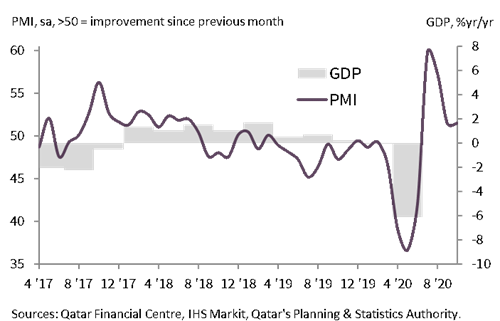Private sector recovery remains on track at start of fourth quarter

A sustained rebound in business conditions of Qatar's non-energy private sector economy was seen in the beginning of the fourth quarter of 2020, according to the October Purchasing Managers’ Index™ (PMI™) survey data. Output and new business both registered elevated growth rates for the fourth consecutive month, and the employment index rose to its highest level since March. With firms reporting rising customer numbers and hopeful of further business wins in the coming months as restrictions are eased further, business expectations improved to the highest since July.
The Qatar PMI indices are compiled from survey responses from a panel of around 400 private sector companies. The panel covers the manufacturing, construction, wholesale, retail, and services sectors, and reflects the structure of the non-energy economy according to official national accounts data.
The PMI registered 51.5 in October, up fractionally from 51.4 in September, driven by strong business expectations and realised transactions. The latest figure was the third-highest since July 2018 and signalled a sustained marked improvement in business conditions in the non-energy private sector economy. Recent performance has registered higher than the long-term average, which since the survey began in April 2017 has trended at 49.5.
At the sub-sector level, the strongest-performing area in October was construction (54.0), following by manufacturing (51.9), wholesale & retail (51.7) and services (48.8).
The two largest components of the PMI – output and new orders – continued to rebound in October, with the respective indices at elevated levels for the fourth successive month. There was a notably sharp rise in new business in the construction sector during the month, which was likely driven by improving weather conditions and lower COVID-19 counts.
Non-energy private sector companies expanded their workforces across the board in October, following a broadly stable labour market during the third quarter. The employment index hit a seven-month high and was well above its long-run trend level. Among the varied sectors, there was a notable boost to hiring among construction companies as activity picked up considerably.
Following the rise in output and new business, the 12-month outlook for business activity improved to the strongest since July. This was reflected in one of the fastest increases in purchasing activity in the survey’s history, and rising levels of outstanding work. As a consequence, the backlogs index registered its second-highest in over two years.
In terms of prices, average input costs were broadly stable during October, although staff costs fell slightly since September. Meanwhile, prices charged for goods and services rose for the third time in four months, which could eventually result in moderate consumer price inflation.
The monthly PMI can be aggregated to a quarterly average to enable comparisons with official gross domestic product (GDP). Since the survey began in April 2017 the quarterly PMI has a correlation of 0.66 with the year-on-year percentage change in GDP in real terms, with a PMI reading of 50.0 equating to 0.2% growth on an annual basis. The latest official data reported a year-on-year decline of 6.1% in real terms in the second quarter of 2020, a figure heavily influenced by the lockdown measures implemented to contain the coronavirus outbreak. The PMI data for the third quarter of 2020 are indicating a rebound in GDP, consistent with a 2.7% year-on-year increase.
QFC Qatar PMI™ vs. GDP

Having signalled a rebound in the non-energy private sector economy in the third quarter, the October PMI survey data suggests that the recovery has been sustained moving into the final quarter of 2020. The Qatari economy shrank by 6.1% in the second quarter as lockdown measures were introduced to fight COVID-19, but the subsequent lifting of these restrictions has led to a swift resumption in growth. Third quarter PMI data are consistent with a year-on-year rise in GDP of 2.7%. Moreover, several survey indicators are pointing to sustained output growth in the final months of 2020, including new business, employment, backlogs and purchasing activity.
Sheikha Alanoud bint Hamad Al-Thani, Managing Director of Business Development, QFC Authority




 Contrast View
Contrast View
 Increase Text
Increase Text
 Decrease Text
Decrease Text
 Reset Text
Reset Text


